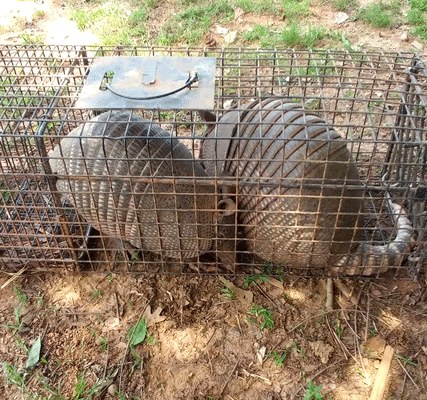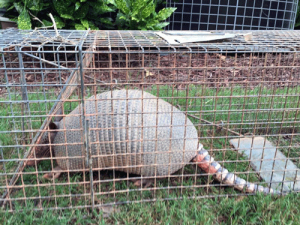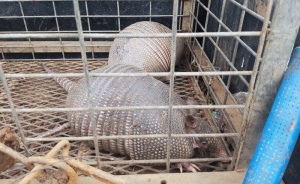
THE INTERESTING ARMADILLO
“The armadillo’s armor is all that you can see. The rest of it is down inside, where it’s very safe to be.” This is our general opinion about the armadillo, which is a species of animals with a very hard shell that looks like armor and lives in burrows. Let’s see how true our assumptions are.
Armadillo solutions
Armadillo Description
- The name, armadillo, is a Spanish word, which means "little armored one." This refers to the leathery shell that is seen covering most of their body.
- Armadillos are closely related to anteaters and sloths. They are approximately two and a half feet long, from the tip of the nose to the tail.
- They come in a wide range of colors. They can be red, pink, grey, yellow, or black.
- Armadillos have sturdy and well-developed legs, especially forelegs for digging up the earth and creating burrows.
- Unlike most mammals that are endothermic with the ability to regulate body temperatures, armadillos do not store body fat, hence cold is a big enemy to them.
- Only the South American three-banded armadillo (Tolypeutes) can roll into a ball when faced with danger.
- The nine-banded armadillo, when startled, can jump 4-5 feet. This predisposes them to road traffic accidents and death.
- Their shells cover their shoulders and hips, with some bands which are separated by loose skin covering their flanks and back.
- The pink armadillos are the smallest and pinkest species of armadillos.
- Fun fact: Armadillos have small squinty eyes and are almost blind but have a keen sense of smell, which aids them in hunting for food and sensing danger from afar.
Armadillos can adapt to any place as long as the climate is warm enough for their survival. Armadillos love habitats that have soft grounds for hunting and foraging, a nearby water source, and adequate heat to support them.
Most live in marshes where they make their burrows and hunt for food. They are generally found in rainforests, grasslands, and semi-forests. They need warm environments to survive, and fluctuations in environmental temperature may wipe off a whole clan of armadillos.
Armadillos sleep for up to 16 hours a day. They are anti-social animals and are only seen late in the evening or early hours of the morning hunting for insects and grubs.
Armadillos are omnivores, meaning that they eat everything from vegetables to insects and larvae. They also eat small vertebrates and, in some cases, may become scavengers.
Generally, armadillos prefer to search underground for their food, with the aid of their very sensitive sense of smell, digging with their strong claws and using their long tongues to catch their prey.
The pregnancy period of armadillos ranges between two to five months, after which young armadillos are birthed into the birthing burrow, which is larger than normal burrows. Baby armadillos are referred to as pups. One armadillo can give birth to about twelve pups at a time, though this is dependent on the species.
Pups are fast-growing and are weaned 2-3 months after birth. After nine to twelve months, pups are mature and ready to have their own families. Armadillos can live up to thirty years.
Armadillos are very anti-social animals that prefer to sleep in their burrows rather than be around other animals and people. They are only ever seen huddling together when they are trying to share body heat. Seven-banded armadillos, however, may sometimes share their burrows, but only with armadillos of the same gender.
Armadillos have specific sounds for hunting and foraging. They grunt as they dig through the earth, pushing their snouts forward. This can be heard from a distance and can be very disturbing, especially if their burrows are underneath the house and patio.
When they are frightened or startled, armadillos tend to squeal and squeak a high-pitched pig-like sound that pierces one's ears. This is their survival instinct towards danger, and when captured by predators, they are quickly released. Screaming hairy armadillos are so-called because of the screaming sounds they make when attacked or faced with danger. They should not be mistaken to be weak or afraid creatures.
They have been known to throw themselves on snakes and other predators when attacked, cutting them to death with the blade-like edges of their shells.
Armadillos are easy to identify and locate. Because they have terrible eyesight, they use the same tracks to their food source and back to their burrows.
Their tracks are similar to those of opossums and raccoons, as they also spread their toes when they walk. They have four toes on their front limbs, with the two toes in the middle elongated and five on their hind limbs, with the three middle toes elongated.
Their sharp claws usually sink into the soft earth as they walk, leaving marks that span 2-3 inches apart, and their tails drag behind them as they walk. Therefore, their tracks have distinctive claw marks with tail trails, making it easy to identify.
One is alerted of the presence of armadillo poop, way before it is seen, by its smell. Their poop has an awful smell, and once you step on it, it is difficult to wipe off and get rid of the smell. Usually, their poop is seen at the entrance of their burrows and are pellets containing remains of insects and other food particles.
DAMAGE-CAUSING ARMADILLOS
Armadillos are small, interesting mammals that come suited with their own armor. This is a strange characteristic for a mammal because most species with shells are invertebrates.
These animals are closely related to anteaters and sloths and can sleep for up to 16 hours a day. They have poor eyesight but are very good hunters due to their excellent sense of smell.
Harmful Armadillo Behaviors
Contrary to public opinion that all armadillos have the ability to roll into their shells in the face of danger, this is only true for the three-banded armadillo. Other species have adopted other survival characteristics. However, some of these characteristics have negative impacts on structures, humans, farms and gardens, and other animals. They include:
- Making burrows:
Armadillos do not have the normal mammalian ability to create warmth for themselves as they have low body metabolism rates and do not have fat stores. They are, therefore, drawn to warmer areas and softer grounds to make homes and have sources for food.Unfortunately, the areas that fit their needs are mostly gardens, farms, and areas below structures and buildings. In trying to make burrows for themselves, they destroy roots of crops, weaken the foundations of structures and deface lawns and gardens.
- Accident hazards:
The nine-banded armadillos, when startled, can jump up to five feet vertically. This can be very dangerous for drivers as they might get into an accident while trying to avoid these creatures.Also, in farms where there are skittish large animals like cattle and horses, a sudden jump can cause them to be nervous and might result in a stampede and injury of those animals and their human handlers.
Armadillo burrows may also cause accidents on farms such as twisting and dislocation of joints and, in worse cases, breaking of bones.
- Defacing property:
Armadillos are omnivores, meaning they eat anything in sight, including flowers and garden plants, decreasing the aesthetic quality of your property. - Damage of wires and pipes:
Their burrowing activities can destroy the wiring systems beneath the ground, which may put you at risk of a power outage and fire outbreaks due to sparks from the disconnected wires. They also tamper with plumbing systems in structures and may cause serious damage with high-cost implications. - Annoying sounds:
They grunt as they search for food, and squeal and squeak when attacked. It seems that armadillos always make sounds in everything they do. This makes them a nuisance, especially since they hunt for food at night and in the morning when humans are most likely asleep.
Their sounds in farms can make animals nervous and restless. This reduces the productivity of animals and places them at risk of a stampede.
- Endangering pet animals: Most pet animals are curious and inquisitive, putting them in danger when they encounter wild animals. Armadillos are very sensitive to danger and, as anti-social animals, often get annoyed when there are trespassers. The screaming hairy armadillos are known to use their sharp armors to tear up predators and can do the same to your pet.
- Public health nuisance: Armadillos, being omnivores, are not selective eaters. Hence they can easily become hosts for many zoonotic disease pathogens.
The damage caused by armadillos can be extensive if not checked. Understanding their habits and characteristics helps you control them and reduce the extent to which they cause damage.
ARMADILLOS: DANGEROUS OR NOT?
Armadillos have become animals of interest in several research works and other life spheres. These unique animals are closely related to anteaters and sloths, with shells that look like armor.
Armadillo is a Spanish word meaning "little armored one." There are nine genera and twenty-one species of armadillos with varying characteristics that distinguish them. Some of these characteristics include color, size, fecundity, and reactions to danger and attacks.
Some characteristics, however, cut across all species. These include their ability to sleep for up to 16 hours a day, inability to generate body warmth, and antisocial behaviors.

Armadillos do not have fat stores and, hence, do not regulate their body temperature like most mammals do, they survive instead by living in warm temperate areas with moist grounds where they can have easy access to food and water.
Due to urbanization and deforestation, armadillos have slowly moved from the wild and made their homes and burrows close to human populations. This raises questions on how dangerous these animals are and if it's safe to cohabit with them.
How Safe Are We?
Though armadillos do us good by feeding on insect pests that would have destroyed plants and crops and served as disease vectors to man and animals, they also pose the following threats:
- Damage of structure and property: The burrowing and foraging activities of armadillos has a negative impact on structures, as they weaken the foundation of these buildings and place them in danger of collapse. Their foraging activities also destroy crops and plants, leading to loss and reduction of profits.
- Accident risks: The presence of their burrows puts one at risk of injury and dislocation when you mistakenly step into them and may damage some farm equipment if not noticed.
- Spook animals: Most animals, especially large animals, are excited or become nervous when there is a sudden noise. When this occurs, they become really restless and may become anxious and aggressive. Armadillos grunt when searching for food and squeak when they feel threatened. These sounds on farms are likely to start a stampede or cause unprovoked attacks on animal handlers.
- Safety hazards: When attacked, armadillos can become vicious. The screaming, hairy armadillos are known to attack predators and cause injuries that may sometimes lead to death. This nature makes it unsafe to have them around as they may attack pets and babies who love to grab things.
- Health risks: Armadillos are reservoirs for a wide range of diseases and pathogens, some
of which are zoonotic and can easily be transferred to man and other animals through contact with their feces. These include: - Salmonella: This causes poisoning and typhoid in man as well as other diseases in animals, which may be fatal. This can be introduced into the food chain through contaminated water and food.
- Rabies: This is rare but still a possibility in some armadillo species. Armadillos are generally shy and antisocial, so an armadillo that seems unafraid and approaches humans may be rabid.
- Tapeworm infection: This can be contracted via contact of pets or man with eggs contained in armadillo poop. They then grow within the intestines and cause damage, malnutrition, and sometimes blood loss to the host.
- Leprosy: Armadillos are well-known carriers of the leprosy bacteria, and due to the similarity of their body temperature to man's, they can easily transmit the bacteria.
Armadillos are quite dangerous both to man and other animals and should be treated and handled cautiously with one's safety as a priority. They should not be allowed on properties, and their burrows should be destroyed with precautionary measures in place to keep them away.
